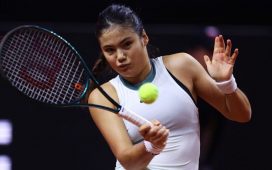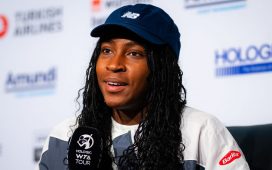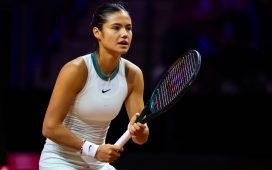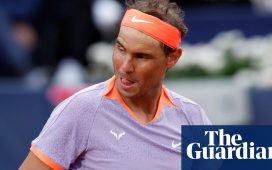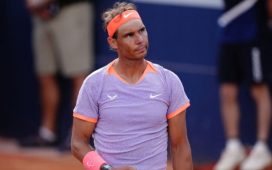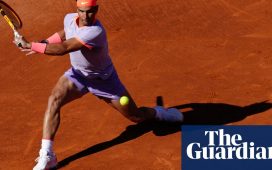When it comes to sporting events that make fashion statements, the US Open gives its players a long runway to rival anything you’d find at New York Fashion Week or even nearby LaGuardia International.
This year, though, instead of Serena Williams in a catsuit or yet another acid-dripped experiment from that funhouse Bethanie Mattek-Sands calls a closet, it was 22-year-old Naomi Osaka taking a virtually empty Arthur Ashe stadium in facemasks bearing the names of Trayvon Martin, Ahmaud Arbery and other Black Americans who died at the hands, knees and bullets of police. It was the fourth-seeded Osaka kicking off her first-round match against fellow Japanese Misaki Doi with the name of no-knock warrant victim Breonna Taylor because “she was most important”. And it was Osaka closing with the name of Tamir Rice on Saturday afternoon before claiming her third major championship in as many years via a resilient 1-6, 6-3, 6-3 US Open final victory over the unseeded Belarusian Victoria Azarenka, a two-time slam champ Osaka was slated to face in the finals of the Western & Southern Open some two weeks earlier until a hamstring injury compelled a last-minute withdrawal. As vogue expressions go, none is more note-perfect for a world reckoning with the twin pandemics of the coronavirus and white supremacy than Osaka’s veiled declarations. And yet the idea that such boldness could come from the world’s ninth-ranked player is surprising to say the least.
Remember: this is the same soft-spoken woman who stole hearts as much with her aggressive ground game and stamina for long games like Saturday’s match-leveling second-set breaker as with her painful shyness during a breakthrough 2018 season that started with her beating back all comers at Indian Wells for the first title of her young WTA career. Shoved in front of a hot center court mic for the traditional post-match ceremony, she wilted in front of the crowd for the first time all tournament, sputtering through her acknowledgements and nearly skipping over opponent Daria Kasatkina before blurting out, finally, “This is probably going to be the worst acceptance speech of all time.” What’s more, Osaka admitted later, she had prepared remarks. It’s just that when she heard her named called over the PA, well, like T’Challa, she froze.
She was at just as much a loss for words after her maiden US Open finals appearance five months later, although this time she was hardly alone. Remember: this was the near flawless victory that saw the testy exchange between Williams and the flinty chair umpire Carlos Ramos – a moment that, like Novak Djokovic’s line judge-pegged default, will forever live in infamy. As boos rained down from the Ashe stands during that post-match coronation, a weepy Osaka slid her visor over her face, prompting Williams to throw a supportive arm around her and whisper a few words of encouragement. Even more embarrassing than this pitched moment was the repugnant newspaper cartoon it inspired in Australia’s Herald Sun depicting the browned-skinned Osaka as a frail blonde woman and Williams as a thick-lipped, racket-stomping mammy.

It wasn’t until after Osaka backed up that major championship with another at the 2019 Australian Open and became first woman since Jennifer Capriati to win her first two slams in consecutive attempts that we’d see a shift in tone. When she went from being the first Asian woman to be ranked No 1 to bombing out of the draws in Miami, Wimbledon and Roland Garros, Osaka finally raised her voice. In a stunning move, she fired the architect of her tour success, the former Williams hitting partner turned coach Sascha Bajin. Reading the comments she gave to CNN Sport a year later, you’d think she might’ve done it sooner if she had only mustered the nerve. “I have a lot of regrets before I go to sleep,” she said, “and most of the regret is that I don’t speak out what I’m thinking.”
When demonstrations against anti-black racism and extrajudicial police killings broke out all over the world in the wake of the unlawful asphyxiation of George Floyd, Osaka was first among prominent athletes to register her support of the Black Lives Matter movement along with the upstart American Coco Gauff, with whom the top-seeded Osaka shared the spotlight and memorably embraced after a third-round route that reduced the Black teen queen to tears. Addressing Gauff’s parents in her on-court interview while choking back tears, Osaka told them, “You guys raised an amazing player. For me, the fact that both of us made it is incredible.”
Osaka even encouraged people in Japan to join protest marches in the city of Osaka, where she resided until age three before moving to South Florida to live and train. All the while, Osaka hit back at any followers who might take issue with her not sticking to sports. Not surprisingly, much of that opposition came from her birth country, where Osaka is grudgingly accepted because she’s hafu – the daughter of a Japanese woman and a Haitian man. And while that technically means she’s mixed race, recent jokes from a pair of Japanese comedians who said she was “too sunburned” and “needed some bleach” or even the blinkered line of questioning about Osaka’s facemasks from the Aussie tennis stalwart turned ESPN analyst Rennae Stubbs were reminders that Osaka, before any nationality, is a Black woman first. That much was clear in the way she beamed during a post-match interview on ESPN’s Ashe Stadium plaza set after watching videos from the mother of Trayvon Martin and the father of Ahmaud Arbery reciprocating her support. “They’re so strong,” she said. “I’m not sure what I would be able to do if I were in their position. I feel like I’m a vessel at this point in order to spread awareness. It’s not gonna dull the pain, but hopefully I can help with anything that they need.”
When the Milwaukee Bucks walked off before a playoff game against the Orlando Magic and triggered the beginning of a two-day sports blackout, Osaka helped make the demonstration stick by boycotting her semi-final match in the Western & Southern Open, effectively grinding that hastily put-together tournament to a halt. Big gestures like this used to be the territory of the Williams sisters, leaders on everything from diversity and inclusion to pay equity to Arab-Israeli relations during their decades-long reign on the women’s tour. And yet even at a Western & Southern Open that was Covid-relocated to US Open grounds named for three American history’s greatest cultural activists, one would be hard pressed to imagine either Venus or Serena taking a time out in a tournament they were winning for political reasons – not because for lack of conviction, but for the hell they would catch. For years, Serena boycotted Indian Wells because of the “undercurrent of racism” her family felt in 2001 and caught nothing but grief for the decision until she returned to the draw in 2015 “with love in mind, and a new understanding of the true meaning of forgiveness.”
Thanks to her and Venus’s trail-blazing efforts, Osaka doesn’t have to apologize for anything or answer to anyone for her activism. She can confidently serve notice that she wasn’t ducking anybody, take her place at Ashe center court and parry Tom Rinaldi’s limp post-match question about the intent of her masked messages with “what was the message that you got?”, before accepting an extra-large silver chalice, a $3m check and, come Monday, the third overall spot on the WTA tour rankings. She can look for all the world like a warrior who could never ever freeze in the moment.
